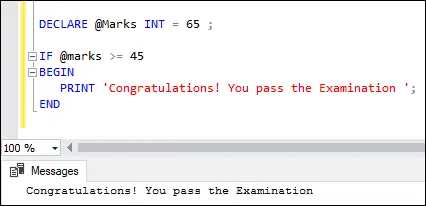IF sakinys yra SQL serverio valdymo srauto funkcijos dalis. Paprastai tai yra sprendimų priėmimo pareiškimas įvairiomis programavimo kalbomis grąžina vertę, pagrįstą nurodytomis sąlygomis . Šis sakinys vykdo kodą, parašytą IF bloke, kai nurodytos sąlygos įvertinimas yra teisingas, o kai sąlyga įvertina klaidingą, tada bus vykdomas ELSE sakinys.
ištrinti paskutinį commit git
IF pareiškimas
Toliau pateikiama sintaksė, iliustruojanti šio teiginio naudojimą SQL serveryje:
IF boolean_expression BEGIN { statement_block } END Aukščiau pateiktoje sintaksėje pareiškimo_blokas viduje PRADĖTI... PABAIGA blokas vykdomas, kai boolean_expression yra patenkintas būkle. Kitu atveju šis blokas praleidžiamas, o programos valdiklis perkeliamas į teiginį po GALAS raktažodį. Turėtume žinoti, kad jei išraiškoje yra a PASIRINKTI pareiškimas, mums reikia padėkite juos skliausteliuose .
Pavyzdys
Pažiūrėkime pavyzdį, kad suprastume IF teiginį be ELSE bloko. Toliau pateiktame pavyzdyje bus rodomas rezultatas, kai sąlyga bus įvykdyta. Kitu atveju programos valdiklis perkeltas į teiginį po raktinio žodžio END, jei toks yra.
DECLARE @Marks INT = 65 ; IF @marks >= 45 BEGIN PRINT 'Congratulations! You pass the Examination'; END
Vykdydami pareiškimą gausite toliau pateiktą išvestį:

Dabar mes tai parodysime toliau pateiktoje Studentas' lentelė su šiais duomenimis:

Žemiau yra dar vienas pavyzdys, kuris gauna bendrų balų pasirinkto studento iš „ Studentas' lentelę pavyzdinėje duomenų bazėje ir išspausdina a žinutę jei tai yra daugiau nei 400 .
reliacinė algebra rdbms
BEGIN DECLARE @Total_Marks INT; SELECT @Total_Marks = total_marks FROM Student WHERE age>25; SELECT @Total_Marks; IF @Total_Marks > 400 BEGIN PRINT 'Congratulations! You pass the Examination'; END END
Gausime žemiau pateiktą išvestį:

Jei norime pamatyti aukščiau pateiktą išvesties pranešimą, turėtume spustelėti Žinutės skirtukas:
atoi c

IF-ELSE pareiškimas
Realiame scenarijuje turime atlikti tam tikrą veiksmą, kai IF sakinio sąlyga yra TRUE arba FALSE. Šiuo atveju naudingas sakinys IF…ELSE. Šis sakinys vykdo ELSE sakinio bloką, kai sąlyga IF sąlygoje yra įvertinta FALSE.
Toliau pateikiama sintaksė, iliustruojanti IF ELSE sakinio naudojimą SQL Server :
IF expression BEGIN Statement block -- It executes when the IF clause expression is TRUE. END ELSE BEGIN Statement block -- It executes when the IF clause expression is FALSE. END
Pavyzdys
Pažiūrėkime pavyzdį, kad suprastume IF teiginį su ELSE bloku. Žemiau pateiktame pavyzdyje bus rodomas pranešimas Sveikiname! Jūs išlaikote Egzaminą “, kai IF sąlyga yra įvykdyta. Kitu atveju rodyti ' Tu nepasisekė! Sėkmės kitą kartą “.
DECLARE @Marks INT; SET @Marks = 65; IF @marks <45 begin print 'congratulations! you pass the examination'; end else 'you are failed! better luck next time'; < pre> <p>Executing the statement will give the below output. Here, the <strong>marks</strong> variable is <strong>65</strong> , and the <strong>condition (65<45)< strong> is not satisfied. Therefore, the message inside the ELSE block is displayed:</45)<></strong></p> <img src="//techcodeview.com/img/sql-server-tutorials/49/sql-server-if-else-5.webp" alt="SQL Server IF ELSE"> <p>We will get this output because the condition <strong>(65>45)</strong> is satisfied. Therefore, the message inside the IF block is displayed:</p> <img src="//techcodeview.com/img/sql-server-tutorials/49/sql-server-if-else-6.webp" alt="SQL Server IF ELSE"> <p>Now, we will demonstrate the IF ELSE statement on the above ' <strong>Student'</strong> table. In this example, we are going to check whether the student <strong>total marks</strong> is <strong>greater than or equal to 400</strong> or not as follows:</p> <ul> <li>When the IF condition is TRUE, we will get the student records whose total marks are greater than or equal to 550.</li> <li>If the condition is FALSE, we will get the student records whose total marks are less than 550.</li> </ul> <p>Here is the program:</p> <pre> DECLARE @Marks INT; SET @Marks = 600 ; IF @Marks >= 550 BEGIN SELECT id, name, gender, age, total_marks FROM Student WHERE total_marks >= 550 ORDER BY age ASC END ELSE BEGIN SELECT id, name, gender, age, total_marks FROM Student WHERE total_marks <550 order by age asc end < pre> <p>In this code, we have specified the <strong>@Marks</strong> variable to <strong>600</strong> , and the condition (600 >= 550) is satisfied. Therefore, we will get the output where student records whose total marks are greater than or equal to 550 are displayed.</p> <img src="//techcodeview.com/img/sql-server-tutorials/49/sql-server-if-else-7.webp" alt="SQL Server IF ELSE"> <p>If we changed the <strong>@Marks</strong> variable to <strong>500</strong> and the condition (500 >= 550) becomes false. Therefore, we will get the output where student records whose total marks are less than 550 are displayed.</p> <img src="//techcodeview.com/img/sql-server-tutorials/49/sql-server-if-else-8.webp" alt="SQL Server IF ELSE"> <h2>Nested IF ELSE Statement</h2> <p>Unlike other programming languages, we can nest an IF...ELSE statement inside another IF...ELSE statement in SQL Server. Let us demonstrate it with the following example:</p> <pre> DECLARE @age INT; SET @age = 6; IF @age <18 50 print 'you are underage'; else begin if @age < below 50'; senior cetizen'; end; pre> <p>In this example, we are going to check whether the <strong>age is underage, below 50, or senior citizen</strong> as follows:</p> <ul> <li>If the value of the <strong>@age</strong> variable is below <strong>18</strong> , it will print the person is <strong>underage</strong> .</li> <li>If the condition is FALSE, the ELSE part will be executed that has a nested IF…ELSE.</li> <li>If the value of the <strong>@age</strong> variable is under <strong>50</strong> , it will print <strong>below 50</strong> . Finally, if no condition is satisfied, it will print <strong>senior citizens</strong> .</li> </ul> <p>Here is the result:</p> <img src="//techcodeview.com/img/sql-server-tutorials/49/sql-server-if-else-9.webp" alt="SQL Server IF ELSE"> <p>This article gives a complete overview of how to use the SQL Server IF ELSE statement. Here we have learned:</p> <ul> <li>Variables are objects that serve as placeholders.</li> <li>The keyword BEGIN will be used to start a statement block, and the END keyword must be used to close it.</li> <li>The use of ELSE in an IF... ELSE statement is optional.</li> <li>It's also possible to nest an IF...ELSE statement inside another IF...ELSE statement. However, nesting an IF statement within another statement is bad practice because it makes the code difficult to read and maintain.</li> </ul> <hr></18></pre></550></pre></45>
